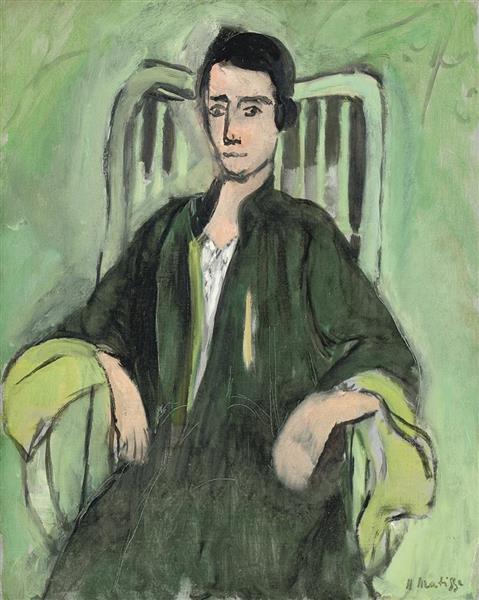Description
Henri Matisse, a giant of modern art known both for the intensity of his color and the boldness of his forms, presents us in "Renée Green Harmony", a work that encapsulates his artistic vision in 1923. This painting, an oil on canvas measuring 48x60 cm, is a showcase of the masterful use of color that distinguishes Matisse. The piece portrays a semi-nude female figure, immersed in an environment that radiates serenity and balance.
Through a detailed inspection of the work, we observe that Matisse uses a luminous green background, possibly alluding to a natural and harmonious atmosphere, which vividly contrasts with the pink-toned floor and the furniture in different shades of blue. The figure of Renée, sitting in a relaxed position on a red cushion, seems to be in a state of contemplation or reflection. The composition is a dance of lines and forms that complement each other, creating a sense of balance. The choice of green as the predominant color is not fortuitous; for Matisse, color was a vehicle to convey emotions and moods, and in this case, green could be associated with a sense of calm and renewal.
The model's posture and her neutral expression suggest an intimacy that is characteristic of many of Matisse's works. The painting is a perfect example of his ability to capture the essence of his subjects without resorting to meticulous detail. Instead, he focuses on shapes and colors to communicate the emotional essence of the moment. The composition reflects a deceptive simplicity, as each element seems to be carefully placed to balance the scene and guide the viewer's gaze around the canvas fluidly.
In addition to its compositional characteristics, "Renée Green Harmony" can also be appreciated in the context of Matisse's artistic journey. In the early 1920s, Matisse was exploring a new palette of colors and simplified forms, in a quest for purity and aesthetic perfection. This period of his career was marked by a departure from the direct influence of Fauvism towards a more personal and mature style.
It is relevant to mention that, although this work does not have the same notoriety as other emblematic pieces by Matisse, such as "The Dance" or "The Joy of Life", it remains a crucial piece within his artistic corpus. It not only highlights his ability to experiment with color and form but also offers a window into his evolutionary process as an artist. Every brushstroke seems imbued with deliberate intention, directing the viewer to a visceral experience of color and form.
In conclusion, Henri Matisse's "Renée Green Harmony" is a work that not only stands out for its visual aesthetics but also for the emotional depth and technical skill it contains. It is a celebration of simplicity and color, a demonstration of how Matisse could transform the everyday into something sublime, and a reminder of why he remains a central figure in the history of modern art.

